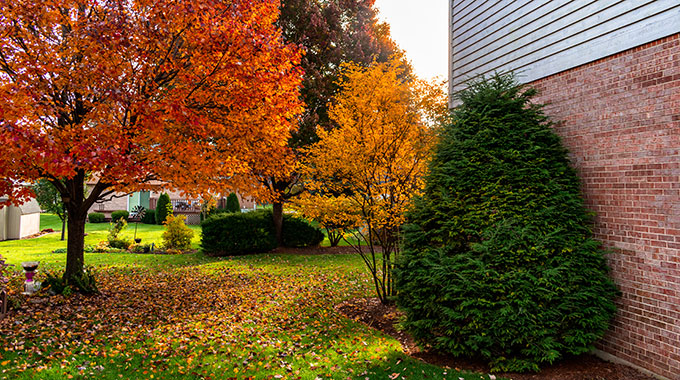
Fall Is for Planning and Planting!
Fall may sometimes be associated with the slowing of your outdoor work, but it’s actually a good time to have landscape work done.
If your landscape needs some reworking or a complete redo, fall is a great time. We’ll clean up, give your property a great “face-lift,” and leave your place primed for spring enjoyment. From the entryway to the driveway, from ground covers to lawns, fall is for planting!
New plantings can easily go in now. Fall-planted shrubs and trees establish quickly, because their green parts have stopped growing, making nutrients more available to their roots. The root system that develops now will support rapid growth and green-up in the spring. Supplies and selection are great in the fall, so let us install that longed-for spring bloomer or row of screening shrubs.
Maybe your entryway could benefit from some sprucing up. If shrubs are straggly, blocking views from inside or detracting from your home’s exterior features, we can help. We’ll trim up or pull out those monsters, tidy up ground cover areas, and widen beds. We can help you choose shrubs that will stay in line and provide seasonal color and year-round beauty that you’ll love coming home to. We also have lots of ways to improve and widen walkways to make your home more accessible and welcoming.
Are you ready to finally add the pool, gazebo or hot tub your family has been asking for? Make next year’s outdoor season complete by having it put in now. You’ll be able to enjoy it from the first warm days. Whatever your landscape needs, we’re ready to help. Our crews are less busy than during the spring rush, so please give us a call with questions or to schedule a personal consultation.

Why Do Trees Change Color?
The process that starts the cascade of events that results in fall color is actually a growth process.
In late summer or early autumn, the days begin to get shorter, and nights are longer. Like most plants, deciduous trees and shrubs are rather sensitive to the length of the dark period each day. When nights become long enough, the cells near the juncture of the leaf and the stem divide rapidly, but they do not expand.
This abscission layer is a corky layer of cells that slowly begins to block transport of materials such as carbohydrates from the leaf to the branch. It also blocks the flow of minerals from the roots into the leaves. Because the starting time of the whole process is dependent on night length, fall colors appear at about the same time each year in a given location, whether temperatures are cooler or warmer than normal.
During the growing season, chlorophyll is replaced constantly in the leaves. Chlorophyll breaks down with exposure to light in the same way that colored paper fades in sunlight. The leaves must manufacture new chlorophyll to replace chlorophyll that is lost in this way. In the fall, when the connection between the leaf and the rest of the plant begins to be blocked off, the production of chlorophyll slows and then stops. In a relatively short time, the chlorophyll disappears completely. This is when autumn colors are revealed. Chlorophyll normally masks the yellow pigments and the orange pigments; both then become visible when the green chlorophyll is gone.
